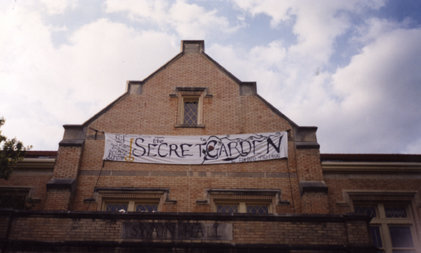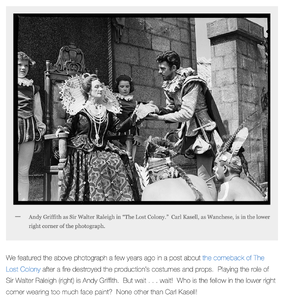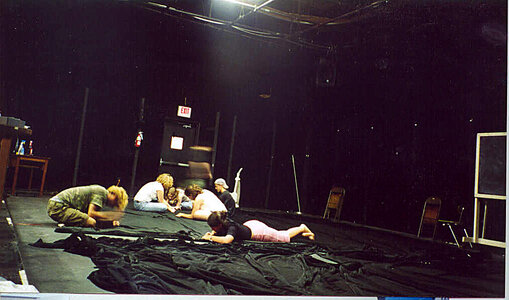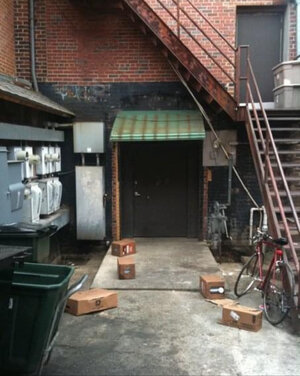Leo’s?Our Mom hated to cook. Absolutely hated it.
It wasn’t like Dad traveled throughout the year (he was a professor - he had to be on campus - and, those first few years he was an untenured assistant professor); in the late ‘60’s and early, early ‘70’s he was off to Goddard Space Center most UNC breaks, some weekends, and good hunks of the summer doing research.
But, when Dad was gone, we ate out…..cheap eats; but, in a restaurant.
With Mom, we’d hit Lum’s (beer-steamed hot dogs; Lum’s became something something and then Colonel Chutney’s; and, is now Pantera Bob’s), The Rat (I LOVED the Cave Room and the Cheese Bowl (aka, Lasagna), Tijuana Fats, and there was a “Greek” restaurant on West Franklin (somewhere between 411 West and Lantern).
Navigation
Install the app
How to install the app on iOS
Follow along with the video below to see how to install our site as a web app on your home screen.
Note: This feature may not be available in some browsers.
More options
You are using an out of date browser. It may not display this or other websites correctly.
You should upgrade or use an alternative browser.
You should upgrade or use an alternative browser.
Chapel Hill/Carrboro History
- Thread starter nycfan
- Start date
- Replies: 816
- Views: 17K
- Off-Topic
donbosco
Inconceivable Member
- Messages
- 3,515
@altmin - you are quite right and I am wrong (I’ll have to dig a bit more on AG’s dorm).

PS - fascinating Life of David Lowry Swain (and Ella) at that link too.
Swain Hall was initially used as dining hall from 1914 to 1940. It could accommodate between 460 and 500 at its fullest capacity, and was “designed for future expansion.”[75] The building was nicknamed “Swine Hall,” a comment on the “quality of the food and the deportment of the diners” eating there.[76] Additionally, the building known as the Abernathy Annex, located next to Swain Hall, was designed to be dressing facility for those working in the kitchens of Swain Hall. It was probably built in the same year.[77] In 1924 the building caught fire, majorly damaging the kitchen and main dining room. After the renovations that followed the building was “as nearly fireproof as possible,” and could then seat 750 students in the dining room. The construction was completed by contractor T.C. Thompson and brothers and architect Atwood and Nash, and cost $11,240.86.[78] The building was reconditioned again in 1936 at a cost of $10,000.[79]
By 1940, even the enlarged building was “signally inadequate” for the demands of the student population.[80] Rather than renovating Swain Hall again, a new dining facility was built in January 1940, Lenoir Hall.[81] Swain Hall was converted to offices, and by 1946 was used by the University’s Extension Division, the Communication Center, and the Photography Library. In 1952 a transmitting tower was installed on the roof, indicating the building as the future home of WUNC radio.[82]
The UNC Department of Radio became its own entity in 1947 when it separated from the Department of Radio, Television, and Motion Picture.[83] The WUNC campus radio station was housed in in the basement of Swain Hall by 1953. The station mostly played classic music and educational programs during its three and a half hours of night sets, with one of the most popular programs being “Let’s Listen to Opera.” The music was introduced by announcers who occasionally read breaking news. Former announcer Carl Kasell remembers one instance in which a win by the basketball team over rival North Carolina State was announced during programming.[84] In 1954 fire escapes were added to the building, and the following year television channel 4 began airing from the building.[85] The hall was again renovated by architect Edward Lowenstein, AIA before it was damaged by another fire, this time thought to be set deliberately.
Swain Hall - Names in Brick and Stone: Histories from UNC's Built Landscape
By Kimberly Oliver Situated near the northwestern edge of UNC’s campus, Swain Hall is often seen as an unremarkable building that bears the name of a remarkable man. It stands as a second-class monument to a man who the university adored and then scorned. It is far from being a campus landmark...
unchistory.web.unc.edu
PS - fascinating Life of David Lowry Swain (and Ella) at that link too.
Lum's became a convenience store owned by Tommy Gardner. Behind that was an open shed which is where Tom Robinson first started selling fish on the weekends before he opened the place in Carrboro.Our Mom hated to cook. Absolutely hated it.
It wasn’t like Dad traveled throughout the year (he was a professor - he had to be on campus - and, those first few years he was an untenured assistant professor); in the late ‘60’s and early, early ‘70’s he was off to Goddard Space Center most UNC breaks, some weekends, and good hunks of the summer doing research.
But, when Dad was gone, we ate out…..cheap eats; but, in a restaurant.
With Mom, we’d hit Lum’s (beer-steamed hot dogs; Lum’s became something something and then Colonel Chutney’s; and, is now Pantera Bob’s), The Rat (I LOVED the Cave Room and the Cheese Bowl (aka, Lasagna), Tijuana Fats, and there was a “Greek” restaurant on West Franklin (somewhere between 411 West and Lantern).
The Greek place was Leo's and was right across from the Cave. I think part of it became an art supply store. In 1970, they served the earliest breakfast in town starting around 6:00 which was important after the all night poker games.
The owner once asked me if I were Greek. I've got the hair color and vaguely the complexion and when I walked in a friend called me Nick which was my nickname, you might say, at the time. There were 5 of us in the group with the same first name and that's a shortened version of my last name and a common nick name for the males of my family.
Not all, though. My dad went by Kate and my grandfather on that side by Sam. My dad's name was Kater (No, I don't know why) and my grandfather's was Charles M. . Apparently , in the first decade of the 20th century, it morphed into C.M. and then into Sam. I remember being surprised that Samuel was not part of his name.
Last edited:
- Messages
- 2,793
I ran a theater company out of Swain while I was at UNC, performing in a black box theater carved out of one of the studios - so I have spent an unhealthy amount of time in that dank building. The walls of the space were initially exposed yellow fibre glass held in place by chicken wire. We painstakingly covered the chicken wire in what seemed like miles of black cloth and then put up painted 1x4's to hold the cloth taught. This was 1996 and I think I still have fiberglass in the sleeves of the leather jacket I wore at the time.@altmin - you are quite right and I am wrong (I’ll have to dig a bit more on AG’s dorm).

Swain Hall - Names in Brick and Stone: Histories from UNC's Built Landscape
By Kimberly Oliver Situated near the northwestern edge of UNC’s campus, Swain Hall is often seen as an unremarkable building that bears the name of a remarkable man. It stands as a second-class monument to a man who the university adored and then scorned. It is far from being a campus landmark...unchistory.web.unc.edu
PS - fascinating Life of David Lowry Swain (and Ella) at that link too.
It was rumored that the floor of Studio 6 (it has some other name now, but that was the name of the black box at the time) was several feet of poured concrete to get rid of the sound of echoing footsteps which drove some diva of the WUNC television era crazy. I can't imagine public radio/ the University would have the funds to rip apart the building, reinforce just that one room and poor extra concrete, but that's what one of the ancient engineers the comm department inherited from the TV days claimed.
Before I had keys to the outside of the building (only inside keys at first) the external doors were locked which was extremely rare back then. We had a matinee that day and it was a weekend. Instead of calling public safety and try to convince them to open the building - I did the more natural thing - break in. From years of hanging banners on the balcony, we knew the windows in the offices above the balcony were painted so many times they couldn't properly lock. Normally we would take a ladder and go on the balcony to hang them, but the ladder was locked inside. Somehow, and I still not sure how I managed this, I climbed the corner pillar of the brick overhand like a ninja and went in through the window to unlock the building.

- Messages
- 2,793
- Messages
- 2,793
I do have an Andy Griffith story though. Now I did not witness it, so it's all hearsay, but I think enough did where it could be believable. The director was not well liked though, so it could have been made up though to disparage him. I believe it was the Fall of 1998 and one of the Drama department theater groups was putting on "Lion in Winter" in Old Playmakers. During an evening rehearsal, some actors became distracted by a man (and maybe others?) lingering in the back of the theater. The director stopped rehearsal and yells across the building "Sir can I help you?" and the man replied "Well I used to spend a lot of time in the building, I just saw it was open and wanted to take a peak in." The director yelled back "Well this is a closed rehearsal, you need to leave!"
After they did, one of the actors said to the director "Do you realize you just threw Andy Griffith out of the building?"
I also learned that in his brief stint as a high school teacher, he taught Carl Kasell.
After they did, one of the actors said to the director "Do you realize you just threw Andy Griffith out of the building?"
I also learned that in his brief stint as a high school teacher, he taught Carl Kasell.
- Messages
- 2,793

Actually the student of Andy Griffith thing is apparently false.
'Kasell confided that Griffith later helped him with a more appropriate application of face paint, and that Griffith was “a big, big help” during that season. (Kasell’s high school drama teacher was Clifton Britton, not Griffith as is often incorrectly stated on numerous web pages.)'
Ddseddse
Esteemed Member
- Messages
- 685
Besides teapot spagetti and ramen that I made in my dorm, my devastatingly poor go tos were the bucket of bones, the free Hare Krishna food (always left mildly disappointed i wasn't proselytized to, nope, just nice people and free food), and the Greek Grilled Cheese (with Chili) at Hetor's.Leo’s?
- Messages
- 1,102
So my age addled mind has hit a roadblock. There was a restaurant that had cheap, not great steaks amongst other things that was down towards Sloan's drugstore. It was the Caolina something. Grill maybe? 1970ish.Our Mom hated to cook. Absolutely hated it.
With Mom, we’d hit Lum’s (beer-steamed hot dogs; Lum’s became something something and then Colonel Chutney’s; and, is now Pantera Bob’s), The Rat (I LOVED the Cave Room and the Cheese Bowl (aka, Lasagna), Tijuana Fats, and there was a “Greek” restaurant on West Franklin (somewhere between 411 West and Lantern).
Any y'all old folk remember?
Thx in advance.
Ddseddse
Esteemed Member
- Messages
- 685
Where, if you don't mind my asking? Not to turn this into the Foodie thread, but I love flank steak but it's gotten so damned expensive, not just inflation, it used to be a third of the price of NY strip but is now damn near the same.Speaking of the Rat, I just found a nice piece of flank steak on sale. Might have to see if I can duplicate the Double Gambler. I know there's a recipe on line somewhere.
Carolina Grill. I think you got a small, like 6 oz sirloin, a salad , fries or a baked potato and tea for a buck eighty five. My orientation counsellor took us the first day on campus.
At lunch, they had three chili dogs for a dollar. I don't remember if fries and a drink came with that or not but I think so. I loved their hotdogs. Had a good breakfast as well. Only place in town that crumbled the sausage and scrambled it with the egg like God intended when they made a sausage and egg sandwich.
At lunch, they had three chili dogs for a dollar. I don't remember if fries and a drink came with that or not but I think so. I loved their hotdogs. Had a good breakfast as well. Only place in town that crumbled the sausage and scrambled it with the egg like God intended when they made a sausage and egg sandwich.
donbosco
Inconceivable Member
- Messages
- 3,515
So my age addled mind has hit a roadblock. There was a restaurant that had cheap, not great steaks amongst other things that was down towards Sloan's drugstore. It was the Caolina something. Grill maybe? 1970ish.
Any y'all old folk remember?
Thx in advance.
Carolina Grill. Lunch for me there was often four chilidogs with fries and a co-cola but they also had a cheeseburger steak. We used to all put a quarter on the table then look to see the bottling location on our drink. The farthest away got the pot.
The guy that made the hot dogs was right up front where you ordered and he made them before your very eyes. He was a speed machine. I can see him now in his apron with a paper restaurant hat balanced on top of his afro.
Yep, the 1970s.
I caught a manager's special at Walmart. It was around 5.89 a pound.Where, if you don't mind my asking? Not to turn this into the Foodie thread, but I love flank steak but it's gotten so damned expensive, not just inflation, it used to be a third of the price of NY strip but is now damn near the same.
For most of what I do, I actually prefer skirt steak or flap meat. I don't even know where to look for flap meat and skirt steak has gotten rare and expensive.
- Messages
- 1,264
IIRC, the Carolina Grill, back in the early 1970's, sold a punch card that cost $9, but could be redeemed for $10. A 10% discount on good cheap food. Seems like I got one every week, but I'm sure it was less frequent than that. I always left my tip in cash. Well, not cash, but in coin. Always ate at the counter.Carolina Grill. Lunch for me there was often four chilidogs with fries and a co-cola but they also had a cheeseburger steak. We used to all put a quarter on the table then look to see the bottling location on our drink. The farthest away got the pot.
The guy that made the hot dogs was right up front where you ordered and he made them before your very eyes. He was a speed machine. I can see him now in his apron with a paper restaurant hat balanced on top of his afro.
Yep, the 1970s.
donbosco
Inconceivable Member
- Messages
- 3,515
That's somewhere around the back of Amber Alley, I believe. It was the closest way to Franklin from the old parking lot on Rosemary.
Nope. You may not be old enough nyc.
Man, like 8-10 years ago it seemed like no one knew what skirt steak was and it was super cheap. Here in the bay area, the secret got out and it got really expensive. One of my favorite cuts of meat.I caught a manager's special at Walmart. It was around 5.89 a pound.
For most of what I do, I actually prefer skirt steak or flap meat. I don't even know where to look for flap meat and skirt steak has gotten rare and expensive.
It's been a dozen years ago but when the Food Lion in Carrboro on Jones Ferry Rd. started catering more to Hispanics than the others, there was a while that I was getting skirt steak and flap meat for 3.99 a pound and frequently would catch manager's specials because people didn't know what to do with it. I didn't mind because I did.Man, like 8-10 years ago it seemed like no one knew what skirt steak was and it was super cheap. Here in the bay area, the secret got out and it got really expensive. One of my favorite cuts of meat.
Share:



